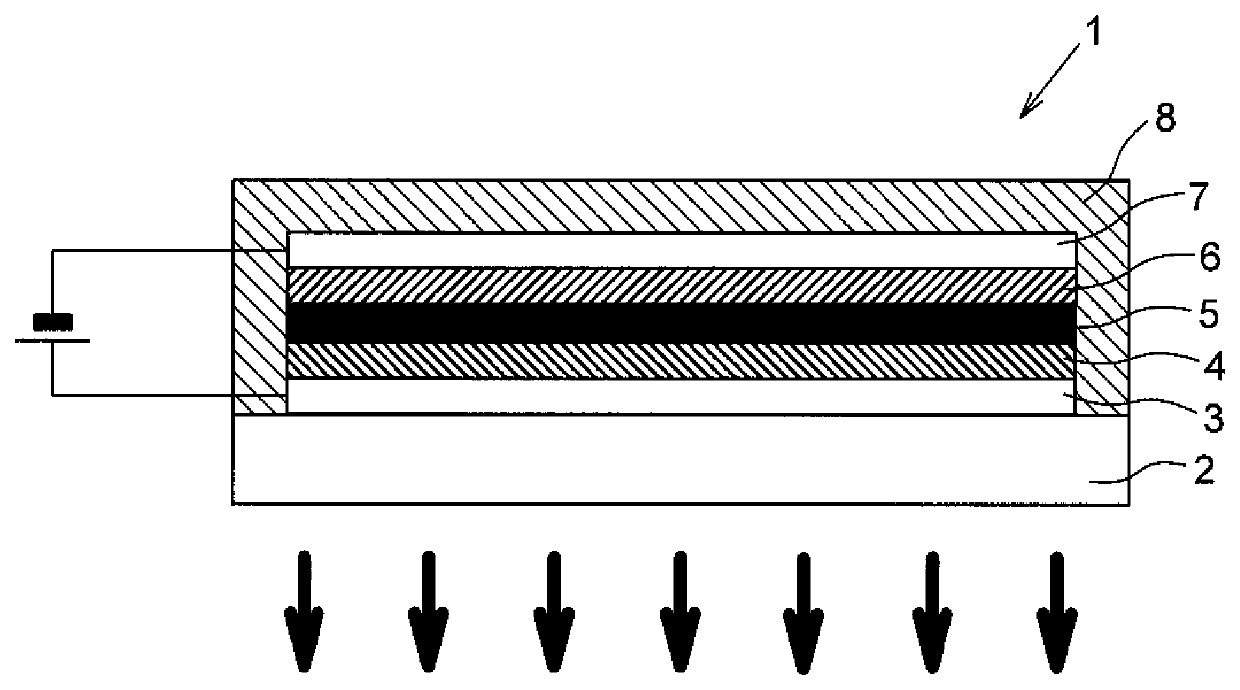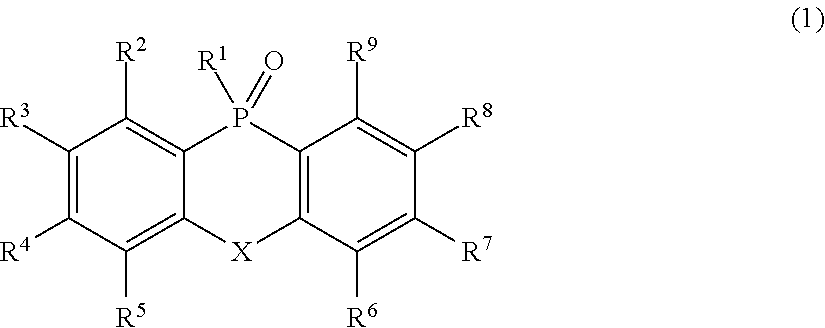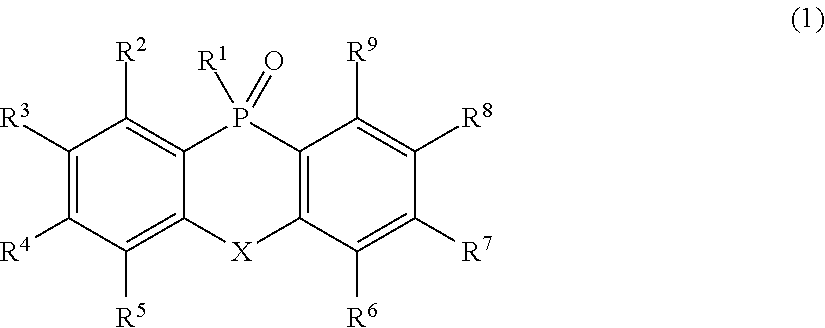Organic electron transport material and organic electroluminescent element using same
a technology of electron transport and organic electroluminescent elements, which is applied in the direction of luminescent compositions, organic chemistry, group 5/15 element organic compounds, etc., can solve the problems of difficult to balance the electron transport properties and hole transport properties of the conductive polymer material used for manufacturing the elements, and difficulty in removing the reaction initiator and unreacted substances, and achieve excellent stability and durability , high chemical stability of a c—p bond
- Summary
- Abstract
- Description
- Claims
- Application Information
AI Technical Summary
Benefits of technology
Problems solved by technology
Method used
Image
Examples
embodiment 1
[0050]An organic electron transport material according to Embodiment 1 of the disclosure (hereinafter simply referred to as “organic electron transport material” in some cases) is a phosphine oxide derivative having a structure represented by the following Formula (1).
[0051]In Formula (1),
[0052]R1 represents an atomic group which has either or both of one or more aryl groups and one or more heteroaryl groups and which may have a phosphine oxide group represented by the following Formula (2) on any one or more carbon atoms.
[0053]R2 to R9 each independently represent an atom or an atomic group selected from the group consisting of a hydrogen atom, a halogen atom, a cyano group, a C1-C12 linear or branched alkyl group, a linear or branched fluoroalkyl group, an aryl group, a substituted aryl group, a heteroaryl group, and a substituted heteroaryl group.
[0054]In Formula (2),
[0055]R11 to R18 each independently represent an atom or an atomic group selected from the group consisting of a h...
embodiment 2
troluminescent Element
[0073]An organic EL element 1, which is one example of the organic electroluminescent element according to Embodiment 2 of the disclosure include a plurality of organic compound layers (in the order of a hole transport layer 4, a light emitting layer 5, and an electron transport layer 6 from the side of a positive electrode 3 in the organic EL element 1 according to the present embodiment), which is layered such that it is sandwiched between the positive electrode 3 and a negative electrode 7 formed on a transparent substrate 2, and the organic EL element 1 as a whole is sealed with the sealing member 8.
[0074]Note that the expression “Y (an electrode or organic compound layer) is provided on X (an electrode or organic compound layer)” means that “Y is present on the surface on the side of negative electrode 7 of X such that the surface of X and the surface of Y are in contact with each other,” and the expression “Y (an electrode or organic compound layer) is fo...
example 1
n of Stability of Phosphine Oxide Derivatives in the Anion State by the First-Principles Calculation Based on the Density Functional Theory Method
[0133]Optimization of the structure and calculation of heat of formation were conducted on a workstation under the following conditions using GAMESS as the calculation program.
[0134]Neutral molecule, cation, anion fragment: RHF (restricted Hartree-Fock method) / 6-31G (d) / B3LYP
[0135]Cation, anion molecule, neutral fragment: UHF (unrestricted Hartree-Fock method) / 6-31G (d) / B3LYP
[0136]Single point calculation was performed on fragment molecules among the above based on the parent ion conformation.
[0137]Based on the results of heat of formation, bond dissociation energy (BDE) of a dissociation reaction represented by the following Formula (1) was calculated.
M→F1+F2 (1)
[0138]In this case, bond dissociation energy is obtained by the following Formula (2).
BDE=HM−(HF1+HF2) (2)
[0139]BDE: Bond dissociation energy
[0140]HM: Heat of formation of the p...
PUM
| Property | Measurement | Unit |
|---|---|---|
| brightness | aaaaa | aaaaa |
| temperature | aaaaa | aaaaa |
| temperature | aaaaa | aaaaa |
Abstract
Description
Claims
Application Information
 Login to View More
Login to View More - Generate Ideas
- Intellectual Property
- Life Sciences
- Materials
- Tech Scout
- Unparalleled Data Quality
- Higher Quality Content
- 60% Fewer Hallucinations
Browse by: Latest US Patents, China's latest patents, Technical Efficacy Thesaurus, Application Domain, Technology Topic, Popular Technical Reports.
© 2025 PatSnap. All rights reserved.Legal|Privacy policy|Modern Slavery Act Transparency Statement|Sitemap|About US| Contact US: help@patsnap.com



